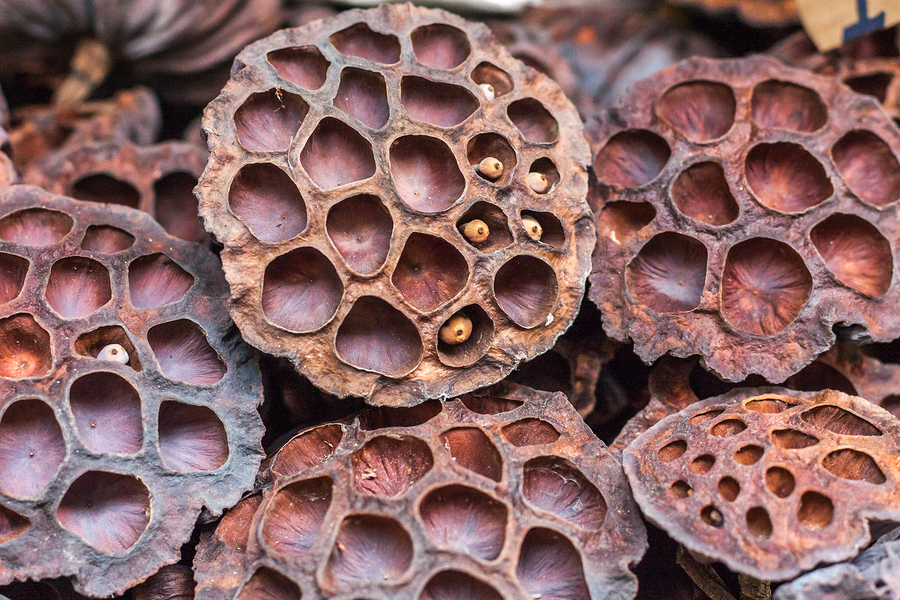 It isn’t difficult to think of someone who has a fear of heights or an aversion to snakes, spiders or bugs. But there is one phobia many people may not be familiar with—one that remains something of a mystery even to psychology professionals—trypophobia.
It isn’t difficult to think of someone who has a fear of heights or an aversion to snakes, spiders or bugs. But there is one phobia many people may not be familiar with—one that remains something of a mystery even to psychology professionals—trypophobia.
An article posted only last month in the journal Frontiers in Psychiatry explained the current knowledge and ongoing obscurities of a phobia that is not yet recognized by such diagnostic classification publications as the Diagnostic and Statistical Manual of Mental Disorders (DSM).
In the article, researchers Juan Carlos Martinez-Aguayo et al discussed the case of “a girl who suffers from a phobia to repetitive patterns, known as trypophobia”. The condition is said to “usually [involve] an intense and disproportionate fear towards holes, repetitive patterns, protrusions, etc., and, in general.”
Fear, Martinez-Aguayo wrote, “is the normal response to danger, while phobias are characterized by excessive, unconscious, and persistent fear that constantly triggers anxiety.” The word trypophobia, he wrote, comes from the Greek trypa meaning drilling or hole. “Trypophobia is basically referred to by people who suffer from it, through communications such as social networks and personal blogs.”
Martinez-Aguayo and his colleagues explained that in the case of the 12-year old referenced in their article, “the patient also suffered from generalized anxiety disorder and was treated with sertraline”. In her initial diagnosis, she displayed “symptoms of both fear and disgust towards trypophobic images [shown to her],” the researchers explained. “After some time following treatment, she only showed disgust towards said images.”
In his recent article for AllPsych.com, writer Neil Petersen examined the research and findings of Martinez-Aguayo et al. He revealed that some hypotheses into the phobia have held that the fear of bumps or holes in repetitive configurations “have historically been associated with evolutionary threats like infectious disease or poisonous animals, but the authors of the recent article point out that so far there’s not much hard evidence for this explanation.”
Petersen explained that in the case of the 12-year-old girl, her fear of repeating bumps and holes could be triggered by a variety of seemingly benign everyday objects . . . [that] included a wall that was being remodeled and a sidewalk with pebbles embedded in it.” Strong emotions of fear and disgust even resulted from “food items like a slice of bread with holes in the surface or a meringue pie with a pattern of bumps in the frosting”.
The girl’s mother explained to the study investigators that her pregnancy for this daughter had been a normal one, and her daughter’s current sixth-grade work produced outstanding scholastic marks—in the 90th percentile.
Further information published about the girl included the fact that she was residing with her mother and a younger sister. She had never lived with her father, but maintained a close relationship, continuing twice-monthly visits.
The girl’s mother experienced generalized anxiety disorder (GAD) herself and had developed “three depressive episodes successfully treated with sertraline”.
For individuals who do not suffer from trypophobia, Petersen wrote in AllPsych, “you might not have noticed, but it turns out that repetitive patterns of bumps and holes are everywhere.”
During an interview with the study’s researchers, the girl was shown “an image of a strawberry” and although she had never eaten the fruit before, she “manifested progressive anguish as the image was expanded; the same happened to the image of vents.”
Based on the information provided by the authors of the Frontiers article, there is some variance in the emotional responses of individuals with trypophobia. “Research indicates that some people react with extreme fear and disgust while others react only with disgust,” Petersen explained.
Based on the limited number of peer-reviewed articles on the subject, researchers Martinez-Aguayo et al concluded that there is much still to be discovered and understood about the phobia.
Petersen too concluded his article with more questions than answers. “Why do these particular images cause such strong reactions for some, and is it a phobia in the traditional sense?” he asked.
“It’s definitely something, though,” Petersen reasoned, given that “as the case of the 12-year-old girl tells us, it has the potential to interfere in everyday life.” The responses also coincide with other types of psychiatric symptoms, he said. “As more research is done, repetitive patterns of bumps and holes could have something to teach us about mental health.”
Although trypophobia may not be mainstream to some, such social media sites as Pinterest and Buzzfeed have received dozens of reports that the recent movie box office hit Black Panther has been triggering audience members who suffer from the phobia. Many moviegoers indicated discomfort when watching a certain character who often appeared shirtless onscreen. The character’s torso was covered with numerous, small, bump-like scars.
Similarly, viewers of American television’s anthology horror series American Horror Story last year reported episodes of trypophobia resulting from ads for the show. Business Insider reporter John Lynch wrote, “An advertising campaign for the new season of American Horror Story has been giving people panic attacks with its disturbing, hole-covered imagery, and the underlying cause is a rare but intense feeling of disgust that scientists are still trying to figure out.”
References
Lynch, J., (September 20, 2017). Business Insider. Ads for this season of ‘American Horror Story’ are giving people panic attacks—here’s the science behind it. http://www.businessinsider.com/why-american-horror-story-ad-giving-americans-panic-attacks-2017-9
Martinez-Aguayo, J.C., Lanfranco, R.C., Arancibia, M., Sepúlveda, E., & Madrid, E., (February 9, 2018). Frontiers in Psychiatry. Trypophobia: What Do We Know So Far? A Case Report and Comprehensive Review of the Literature. https://www.frontiersin.org/articles/10.3389/fpsyt.2018.00015/full
Petersen, N., (February 27, 2018). AllPsych.com The Mystery of Trypophobia. https://blog.allpsych.com/the-mystery-of-trypophobia/
TimesHeraldNews.com. (Retrieved March 10, 2018). “Black Panther” Triggered My Trypophobia And I Watched It Anyway. https://www.timesheraldnews.com/world/-black-panther-triggered-my-trypophobia-and-i-watched-it-anyway-k5ejuhwaoe